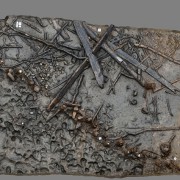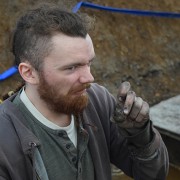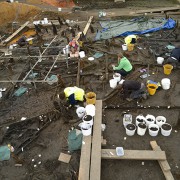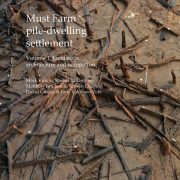Post-Ex Diary 19: The Importance of Visualisation – Illustration
December 9, 2019
In our last post-excavation diary we discussed how valuable photogrammetry is during our current research into the Must Farm pile-dwelling. Visualisations are vital for developing our interpretation of the site’s archaeology and another essential technique during post-excavation is illustration.
Archaeological illustration involves recording and visually presenting artefacts, sites and information gained from excavations in a range of mediums and formats. Typically, this work takes the form of technical scale drawings, location maps, site and distribution plans, charts and detailed reconstructions. During the excavation we discussed the role illustration had on-site (see Dig Diary 24: Visualising the Site) where it was used to draw fragile in situ artefacts and create working plans of the site. However, this visualisation process is just as important, if not more so, in our current post-excavation work.
Artefact Illustrations
Scale artefact drawings are often the first thing that comes to mind when people think about archaeological illustration. These technical, measured drawings are used to depict artefacts of all materials, ranging from worked flint and bronzes to tiny, delicate textile fragments.
We are often asked why we don’t simply photograph these artefacts using the high-resolution cameras that are widely available instead of drawing them. We do make extensive use of photographs which is another valuable visualisation technique both during and after an excavation. Yet, illustration is a very different process that shows detail and information that is difficult to capture and represent in other formats.
Archaeological illustrators are both archaeologists and illustrators. The scale artefact drawings they produce reflect their knowledge and experience and highlight a range of subtle details that are essential to representing the objects clearly. Artefact illustrations are interpretative drawings that can highlight elements that might not be obvious in a photograph and can emphasise important aspects of an object that are otherwise difficult to distinguish. The interpretative element of these illustrations differentiates them from high-resolution photographs.
Importantly, there are different graphic conventions for each type of artefact which creates consistency between sites and publications. When specialists look at illustrations they are able to “read” these conventions and immediately understand similarities and differences between other assemblages of the same material.
Our artefact drawings can vary significantly between object type ranging from enormous structural timbers to the smallest beads. They can also be relatively simple such as the profiles of different pots to much more complex, schematic illustrations that show how textiles were manufactured or folded. Drawings can highlight subtle details that provide essential insight into how artefacts were used, such as the traces of use wear on the blades of bronze axes.
Even the simplest of illustrations can be used to reconstruct other details of an artefact. Recently, we’ve been reconstructing the volumes of Must Farm’s vessels using the scale illustrations of their interior profiles to help us do so. This is exciting as we can do this even for incomplete pots, as long as we have sherds that form a complete profile. From a 2D line-drawing it is possible to create a 3D visualisation of a vessel, allowing us a more comprehensive overview of our assemblage that helps to digitally remake incomplete pots.
More information on this process can be found here: Vessel Volumes.
Graphics
Alongside artefact illustrations, graphics play a major role during post-excavation. These illustrations cover a much wider range of subjects that can help us to refine and develop our interpretations and understanding of the Must Farm pile-dwelling in several ways. One of the most immediate roles of graphics within archaeology is the representation of the archaeological data gathered during the excavation.
This process involves closely working with specialists from different areas, including photography, geomatics and material types, to create graphics of different aspects of the site. Here an archaeological illustrator works to represent the interpretation of Must Farm, visually. This can involve using survey data to highlight the distributions of certain artefact types across the site, to look for patterns and themes. It can also take the form of visualisations that focus on an individual feature of the site, such as Must Farm’s Roundhouse One, and examine differences in artefacts found directly beneath the structure and those outside of it.

Plan of a dense area of Structure One with artefacts highlighted and the wood mass and structural elements in grey.
Graphics that highlight artefact types or aspects of the site are essential to the post-excavation process and directly inform and guide our interpretation of the archaeology. They can emphasise patterns and features in the material and archaeology that weren’t apparent during the excavation. Similarly, their flexibility and the ease at which they can be manipulated and updated mean that graphics can help refine our existing theories by providing a general overview or a detailed snapshot.
Crucially, the creation of graphics is a continuous process beginning during the excavation but constantly evolving throughout post-excavation to incorporate new evidence and current specialist feedback. Post-excavation is a very active process, and while it takes place at a different pace from excavation, it is essential for any project to create original and updated graphics. These visualisations are vital at steering lines of enquiry in new directions and highlighting areas of interest within the data.
From our graphics, can we see that each structure has a similar “inventory” of material or are there differences? Across the site is material deposited in the same way or are there other patterns? If so, what could the reasons for this be? Can we use visualisations of the site and its materials to gain insight into the fire that destroyed the pile-dwelling settlement?
Reconstructions
Reconstruction drawings are another important element of archaeological illustration and are typically associated with the end of a project. However, these forms of visualisation also evolve over time changing to incorporate updated information. The act of having to reconstruct a component of a site visually assists our interpretation by making us think carefully about the evidence. Reconstructions can vary substantially, from more simple schematic drawings to full scenes.
From early in the excavation we were keen to create a schematic illustration to present a simple representation of how one of our pile-dwellings would have been constructed as a stilted roundhouse was not something typically encountered in British prehistory. Our first drawing incorporated what we understood our pile-dwellings to be at the time. Over the course of the project we have continually updated and amended the reconstruction to reflect changes in our interpretation of the structures and to incorporate the new discoveries we have made within the archaeology. Undoubtedly our current version will evolve further as post-excavation continues but it reflects the importance of keeping illustrations current and acknowledging that interpretations develop through research.

Evolution of the Structure One schematic showing how new interpretations are incorporated into illustrations
Similarly, larger reconstructions, such as illustrations reflecting the whole settlement, are complex and time-consuming undertakings. Here, we must carefully consider all the available evidence and ensure our image is as “complete” as possible. All the archaeological data and scientific results must be taken into consideration in presenting our visualisation to ensure it is as true to our interpretation as possible.
Illustration is a core component of any archaeological project and is absolutely essential during the post-excavation process. These visualisations enable us to present information clearly, emphasise important elements and help guide our interpretations towards a better understanding of Must Farm’s archaeology.
Related stories
Post Ex-Diary 22: Working Towards Publication
May 11, 2020
Post Ex-Diary 21: The Importance of Visualisation – Photography Part Two
February 17, 2020
Post-Ex Diary 19: The Importance of Visualisation – Illustration
December 9, 2019
Post-Ex Diary 18: The Importance of Visualisation – Photogrammetry
November 11, 2019
Post-Ex Diary 17: Stable Isotope Analyses and Must Farm
October 7, 2019
Post Ex-Diary 16: Parasites and Lifestyles at Must Farm
September 3, 2019
Post Ex-Diary 15: Exploring Structure 4 Part Two
August 5, 2019
Post Ex-Diary 14: Exploring Structure 4 Part One
July 15, 2019
Post-Ex Diary 13: The Must Farm Pile-Dwelling Settlement Open Access Antiquity Article
June 12, 2019
Post-Ex Diary 11: The Must Farm Textiles Part One
April 1, 2019
Post-Ex Diary 10: Specialist Analyses Part Three
March 4, 2019
Post-Ex Diary 9: Specialist Analyses Part Two
February 4, 2019
Post-Ex Diary 8: Specialist Analyses Part One
January 7, 2019
Post-Ex Diary 7: The Must Farm Pottery Refit
November 5, 2018
Learn more
About
The Must Farm pile-dwelling settlement was excavated by the Cambridge Archaeological Unit with funding from Historic England and Forterra.Publications
Read the Open Access publications the Must Farm pile-dwelling settlement: Volume 1. Landscape, architecture and occupation and Volume 2. Specialist reports.Dig Diaries
The excavation of the Must Farm settlement was carried out between August 2015 and August 2016. Take a look at our diary entries documenting the excavation process. ...read more
Discoveries
See some of the discoveries from the Must Farm pile-dwelling settlement.
Making Must Farm
Find out about our work with AncientCraft recreating Must Farm’s material.
FAQs
Further information on the Must Farm project.




























